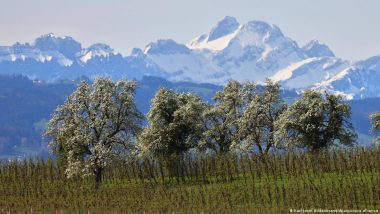They are key allies against climate change, provide food and clean water, and can even lift our mood. Without them, our past and future would look very different. Explore the many wonderful jobs trees do for us.Many first memories of trees might be of clambering among their branches or seeing the fruit that grows on their branches. But while they are familiar to us all, what exactly are trees?
Also Read | Business News | What Does International Travel Insurance Cover?.
Biologically speaking, they are perennial plants with a woody trunk and branches that can grow to be spectacularly tall.
Also Read | Business News | BMW Group India Launches Its Monsoon Service Campaign.
And they are vital for our survival. This is because trees provide many so-called 'ecosystem services', which are defined as "direct or indirect contributions of ecosystems to human well-being".
The ecosystem services of trees
Trees supply us with a huge variety of food, including apples, avocados, dates, nuts, olives and citrus fruits, to name but a few.
And their wood has been central to the development of human civilization — without it we wouldn't have come very far. Even Ötzi, the famous 5300-year-old ice mummy, carried a bow made from a yew tree. Wood has long been used as a fuel and building material, as well as a resource to make furniture, musical instruments, paper and textile fibers such as viscose.
Trees provide air, water and reduce noise
But their greatest service is that they help us to breathe. In order to grow, trees carry out what is known as photosynthesis.
During this process they absorb the climate-damaging greenhouse gas carbon dioxide (CO2) from the air and, with the help of sunlight, convert it into sugar which provides energy to grow. A by-product of photosynthesis is oxygen, without which we could not survive on our planet.
Exactly how much oxygen is produced depends on the type and age of the tree: evergreen conifers produce oxygen continuously, deciduous trees only when they have leaves. According to several sources, a mature beech tree can supply ten people with oxygen per year. Its leaves also filter a significant amount of dust, bacteria and fungal spores from the air.
Natural air conditioners and CO2 stores
Come the heat of the summer, the leaves of a tree provide us with much-needed shade, as well as protecting against UV radiation and cooling the air around them.
For example, beech trees evaporate 400-500 liters of water per day through their leaves, cooling surroundings by 3-6 degrees Celsius (37-42 Fahrenheit). Those same leaves can dampen noise in cities.
And then there are the roots, which not only allow trees to store rain in the soil and filter it to ensure clean groundwater. They also help to keep the ground firm even on a slope or during heavy rainfall and play a major role in sequestering emissions.
Because wood is not only a renewable raw material, it also stores climate-damaging CO2, which trees absorb from the air during photosynthesis and also keep in the ground via their roots.
According to scientific estimates, around 4.3 billion tons of CO2 is currently stored in Germany's forests alone. Woodlands also actively remove around 52 million tons of C02 from the atmosphere every year.
Some trees absorb more CO2 than others. According to the environmental organization Greenpeace, beech trees can store almost one ton more CO2 over the course of 100 years than spruce trees of the same size. And the older a tree is, the more carbon dioxide it can absorb.
When wood is burned or rots, however, the greenhouse gas escapes back into the atmosphere.
No trees, no squirrels — and vice versa
A single tree can be a home to many creatures.
Around 200 different species such as insects and spiders live on an old oak or beech tree. These in turn serve as food for birds, bats and squirrels, which also find nesting and roosting sites on trees.
In other words: without trees, we would likely not hear birds singing or be able to see squirrels playfully chasing each other. And without squirrels or birds, fewer trees would grow, since they play a role in seed distribution.
Forest bathing: how trees reduce stress
It is not yet known exactly how it works, but spending time around trees — also known as forest bathing — is good for us.
According to some scientific studies, it can lift our mood, reduce stress, improve our cognitive function and even strengthen our cardiovascular and immune systems. Our whole body seems to regenerate in the forest.
This positive effect might have something to do with organic compounds known as phytoncides, which we absorb from the forest air through our lungs.
Studies have suggested they may be able to inhibit the growth of liver cancer cells and increase the activity of natural killer cells, which are critical to the body's defenses. Although the studies are not yet fully conclusive, it has been repeatedly shown that the forest and its trees have a positive effect on human health.
And if that is not enough evidence of how amazing trees are, there's also this: the tallest tree is currently a giant redwood in California, which measures a staggering 115.55 meters, and the oldest tree, a spruce on Mount Fulu in Sweden, is estimated to be 9550 years old. Aren't trees just great?
Edited by: Tamsin Walker
(The above story first appeared on LatestLY on Jun 28, 2024 03:40 PM IST. For more news and updates on politics, world, sports, entertainment and lifestyle, log on to our website latestly.com).












 Quickly
Quickly













 SRH
SRH







